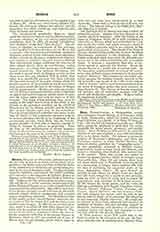

Huesca, Diocese of (OSCENSIS), embraces parts of the province of Huesca in northeastern Spain, seven parishes in the Broto valley and three within the limits of the Archdiocese of Saragossa, one parish being situated in the city of Saragossa itself. Its date of origin cannot be definitely ascertained; the earliest evidence of its existence is the signature of Gabinius, Bishop of Huesca, to the decrees of the council held at Toledo in 589. Isidore of Seville, writing in the seventh century, (De viris illustr—c. xxxiv) mentions the presence of Elpidius, Bishop of Huesca, at an earlier council, but this is not considered authoritative. After 589 we next hear of the diocese through a synod held there in 598 which ordered annual diocesan conferences and enacted various disciplinary measures. The Moorish invasion of 710 rapidly worked toward Huesca; when the city was taken in 713 the bishop fled, and the diocese was directed from Aragon. In 1063 the see was moved to Jaca, where it remained till 1096 when Huesca was retaken and the original see restored by Pedro I. The history of the Diocese of Huesca is from this time on closely associated with that of the present Diocese of Barbastro, which in 1571 was erected out of part of Huesca and, though formally joined with it again in 1851, has ever since been administered by a vicar Apostolic. From 1848 to 1851 the See of Huesca was vacant. The present bishop is the Right Rev. Mariano Supervia y Lostald.
The episcopal city of Huesca was long a center for education and art. Ancient Osca was the seat of the famous school of Sertorius. After the failure of his plans at Perpignan, Pedro IV in 1354 established a university at Huesca, which was maintained by a tax laid on the city’s food, and which pursued a steady if not a brilliant existence until it was eclipsed by the great college at Saragossa. The church of St. Peter at Huesca, erected between 1100-1241, is one of the oldest Romanesque structures in the Peninsula, and the Gothic cathedral which dates from the fifteenth century is one of the architectural landmarks of northern Spain. It contains a magnificent high altar of alabaster carved to represent the Passion. About the present Huesca is a double line of ancient walls. In the immediate neighborhood are several old monasteries, that of Monti-Araj on containing in its crypt the tomb of Alfonso I. The institute for secondary education occupies the building formerly devoted to the old university, and in one of its vaults is the famous “Bell of Huesca”, said to have been constructed from the heads of insurgent nobles who were executed by King Ramiro II. The Diocese of Huesca comprises 181 parishes and 15 subsidiary parishes, with 240 priests and 50 churches and chapels. It has a Catholic population of 87,659.
STANLEY J. QUINN

